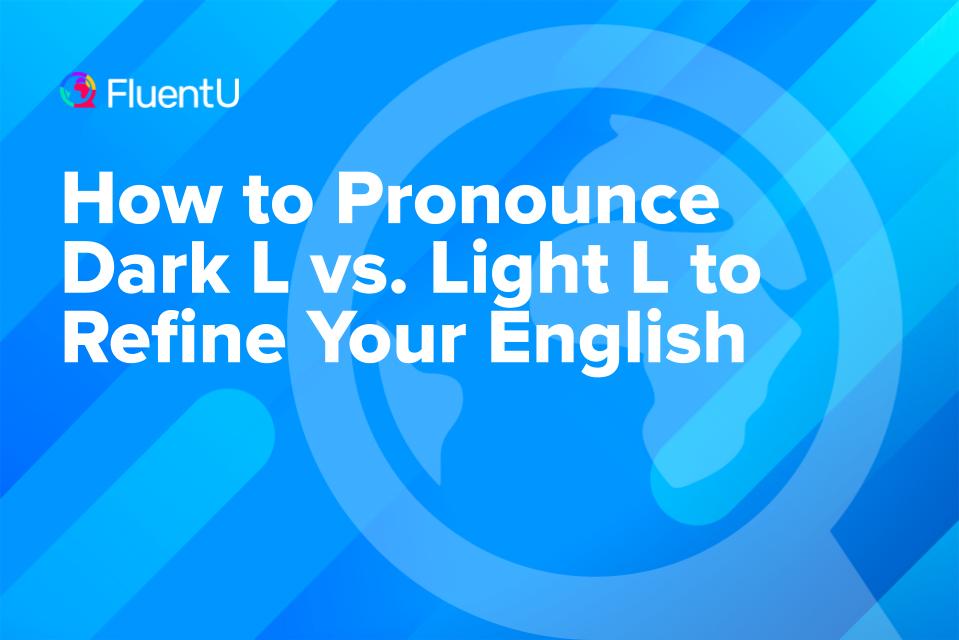How to Pronounce Dark L vs. Light L to Refine Your English

Did you know that the words “laugh” and “smile” actually have different L sounds?
It’s one of the quirks of English – some consonants can be pronounced in more than one way.
In particular, there are two types of L sounds in English, and they have memorable names: the light L and the dark L. For clear English, you’ll need to be able to pronounce both smoothly.
So what sets these two kinds of L apart, and when do you use them?
We’ll be going over that soon in this blog post!
Download: This blog post is available as a convenient and portable PDF that you can take anywhere. Click here to get a copy. (Download)
More than One Kind of L
The letter L is one of the most prominent allophones in English. An allophone has more than one correct pronunciation, but these pronunciations aren’t interchangeable – they’re meant to be used in specific situations.
If you stick with only one kind of L, the rhythm of your sentences might change, which can make it harder for other people to understand you. When this happens across several words in a conversation, the other person might stop processing your words efficiently, and communication breaks down.
What is the Light L?
The light L is the sound that’s usually taught first to English learners. In the International Phonetic Alphabet (IPA), the symbol for it is /l/.
It’s the L that we use when we spell out words, and it’s the sound we hear when reciting the alphabet, as in “H, I, J, K, L…” In fact, a lot of learners might mistakenly think that the light L is the only way to pronounce L.
This form of L is found at the start of words and at the start of syllables.
Here are some examples:
- Lucky
- Lantern
- Lose
- Fee-ling
- Careful-ly
- Dis-like
It’s called light L because it’s easier or “lighter” to pronounce compared to the dark L. It’s right at the tip of your tongue – you lift your tongue and touch the tip against the back of your front teeth to make the sound.
What is the Dark L?
While there are languages such as Russian that use the dark L heavily, most English learners will find it more unfamiliar than the light L. Most of the time, it has the same IPA symbol as the light L: /l/. However, you’ll occasionally see it written as /ɫ/.
The dark L is found at the end of words and syllables.
These words all have a dark L:
- Fall
- Able
- Beautiful
- Al-right
- Hall-mark
- Doll-house
Unlike the light L, you need to curl up your tongue and stop it in the middle of your mouth, as if it’s frozen in mid-motion. It feels a bit more “uncomfortable” to pronounce because there’s a tightening in your throat.
Comparing Dark L vs. Light L
There are three main differences between the Dark L and the Light L:
1. Tongue positioning
From the outside, your mouth is in a slightly open, neutral position when you’re pronouncing either the dark L or the light L.
However, with light L, your tongue is making contact with the back of your front teeth. If you look at a mirror while saying the light L, you should see the underside of your tongue because it’s reaching up.
On the other hand, for dark L, the tip of your tongue is lifted up too, but it’s hanging in mid-air and not touching any part of your mouth. You can think of the shape of your tongue here as like a shallow bowl that’s rounded up, with the tip of your tongue at the edge.
2. Sound
The light L is also called the clear L because it’s only one sound. You can even say it in a prolonged way by keeping your tongue in place: “Lllllllll…”
The dark L is made up of two sounds. If we slow down how a native speaker pronounces the word “fall,” there’s a small uh sound right between the A and the L. This ends up sounding more like faw–uhl.
3. Usage
As we described above, it’s fast to remember when to use the light L and the dark L. It simply depends on where the L is in the word – a light L would be at the start of a word or syllable, and a dark L would be at the end. You can also think of this as the light L having a vowel after it, while a dark L would have the vowel before.
Still, there are edge cases where a dark L can change into a light L as it changes position. For example, “real” uses a dark L, but this becomes a light L in “really” because the L moves to the start of the syllable.
Dark L vs. Light L in Sentences
Now that you have a better idea of the differences between the two L sounds, let’s take a look at full sentences containing L sounds:
Sentences with a Light L
- I love taking long walks out in nature because it’s so peaceful.
- What’s your favorite part of learning a language?
- The light keeps flickering on and off.
- The dragonflies are so lovely to watch.
- You left your notes at the library!
Sentences with a Dark L
- She threw the ball too far, and it rolled down the hill.
- Are you sure you’ll be able to make it?
- He’s going to help them with the table arrangement.
- There’s a puddle on the ground because someone spilled the juice!
- This is the real deal.
Identifying Dark L vs. Light L
Try identifying whether each of the underlined words below uses a light L or a dark L:
- These flowers are great for brightening up the room.
- We have to tell the participants.
- There’s no need to pack an additional set of clothes.
- That comedian makes me laugh the most.
- Would you rather have soup or a salad?
You can check your answers here:
- Flowers – light L
- Tell – dark L
- Additional – dark L
- Laugh – light L
- Salad – light L
Conclusion
You know that you’re communicating well if other people understand your message right away. When you’re aware of the differences between the dark L and light L, your pronunciation will be easier to understand compared to if you’re only saying one kind of L or mixing the two up. In a world where effective communication is so important, learning these finer points of English pronunciation will pay off!







